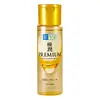What's inside
What's inside
 Key Ingredients
Key Ingredients

 Benefits
Benefits

 Concerns
Concerns

No concerns
 Ingredients Side-by-side
Ingredients Side-by-side

Water
Skin ConditioningButylene Glycol
HumectantHydroxyethyl Urea
HumectantPPG-10 Methyl Glucose Ether
Skin ConditioningDiglycerin
HumectantSodium Hyaluronate
HumectantHydrolyzed Hyaluronic Acid
HumectantSodium Acetylated Hyaluronate
HumectantHydroxypropyltrimonium Hyaluronate
Sodium Hyaluronate Crosspolymer
HumectantLactobacillus/Sodium Hyaluronate Ferment Filtrate
EmollientHydrolyzed Sodium Hyaluronate
Skin ConditioningSaccharide Hydrolysate
HumectantHydrogenated Starch Hydrolysate
HumectantGlycosyl Trehalose
Emulsion StabilisingSorbitol
HumectantTriethyl Citrate
MaskingPEG-32
HumectantCarbomer
Emulsion StabilisingPEG-75
HumectantDisodium Succinate
MaskingPropanediol
SolventDiethoxyethyl Succinate
SolventPotassium Hydroxide
BufferingSuccinic Acid
BufferingDisodium EDTA
Polyquaternium-51
Skin ConditioningCaprylhydroxamic Acid
Hydroxyethylcellulose
Emulsion StabilisingXanthan Gum
EmulsifyingPhenoxyethanol
PreservativeWater, Butylene Glycol, Hydroxyethyl Urea, PPG-10 Methyl Glucose Ether, Diglycerin, Sodium Hyaluronate, Hydrolyzed Hyaluronic Acid, Sodium Acetylated Hyaluronate, Hydroxypropyltrimonium Hyaluronate, Sodium Hyaluronate Crosspolymer, Lactobacillus/Sodium Hyaluronate Ferment Filtrate, Hydrolyzed Sodium Hyaluronate, Saccharide Hydrolysate, Hydrogenated Starch Hydrolysate, Glycosyl Trehalose, Sorbitol, Triethyl Citrate, PEG-32, Carbomer, PEG-75, Disodium Succinate, Propanediol, Diethoxyethyl Succinate, Potassium Hydroxide, Succinic Acid, Disodium EDTA, Polyquaternium-51, Caprylhydroxamic Acid, Hydroxyethylcellulose, Xanthan Gum, Phenoxyethanol
Water
Skin ConditioningCentaurea Cyanus Flower Water
Skin ConditioningGlycerin
HumectantPanthenol
Skin ConditioningPentylene Glycol
Skin ConditioningAlcohol
AntimicrobialEuphrasia Officinalis Extract
AntimicrobialAcmella Oleracea Extract
Skin ProtectingHydrolyzed Hyaluronic Acid
HumectantHydrolyzed Sodium Hyaluronate
Skin ConditioningSodium Hyaluronate
HumectantPantolactone
HumectantPolyglyceryl-10 Laurate
Skin ConditioningCaprylyl/Capryl Glucoside
CleansingSclerotium Gum
Emulsion StabilisingGranite
Skin ConditioningWater, Centaurea Cyanus Flower Water, Glycerin, Panthenol, Pentylene Glycol, Alcohol, Euphrasia Officinalis Extract, Acmella Oleracea Extract, Hydrolyzed Hyaluronic Acid, Hydrolyzed Sodium Hyaluronate, Sodium Hyaluronate, Pantolactone, Polyglyceryl-10 Laurate, Caprylyl/Capryl Glucoside, Sclerotium Gum, Granite
 Reviews
Reviews

Alternatives
Ingredients Explained
These ingredients are found in both products.
Ingredients higher up in an ingredient list are typically present in a larger amount.
Hydrolyzed Hyaluronic Acid is a form of hyaluronic acid. It is created by the hydrolysis of hyaluronic acid with a high molecular weight. Once created, Hydrolyzed Hyaluronic Acid has a low molecular weight.
Low molecular weight HA has been shown to hydrate and increase elasticity of the skin. Increasing elasticity is also associated with reduction of wrinkle depth.
One study found topical low molecular weight hyaluronic acid may be considered for the treatment of rosacea in the adult population. However, we always recommend speaking with a professional about your skin concerns.
Hyaluronic acids are a humectant. This means they draw moisture from the air. Hyaluronic acids help moisturize, soothe, and protect the skin.
Read more about other common forms of hyaluronic acid:
Learn more about Hydrolyzed Hyaluronic AcidThis ingredient is created by putting sodium hyaluronate through hydrolysis.
You might know this as 'mini' or 'ultra low-molecular weight' hyaluronic acid. The small molecule size means it is able to travel deeper in the skin.
According to studies, low molecular-weight hyaluronic acid can:
One study from 2011 found ultra-low weight HA to show pro-inflammatory properties. Another study from 2022 found it to downregulate UV-B induced inflammation.
Hydrolysis is a process of changing a molecule using water or enzymes.
This ingredient is water-soluble.
Learn more about Hydrolyzed Sodium HyaluronateSodium Hyaluronate is hyaluronic acid's salt form. It is commonly derived from the sodium salt of hyaluronic acid.
Like hyaluronic acid, it is great at holding water and acts as a humectant. This makes it a great skin hydrating ingredient.
Sodium Hyaluronate is naturally occurring in our bodies and is mostly found in eye fluid and joints.
These are some other common types of Hyaluronic Acid:
Learn more about Sodium HyaluronateWater. It's the most common cosmetic ingredient of all. You'll usually see it at the top of ingredient lists, meaning that it makes up the largest part of the product.
So why is it so popular? Water most often acts as a solvent - this means that it helps dissolve other ingredients into the formulation.
You'll also recognize water as that liquid we all need to stay alive. If you see this, drink a glass of water. Stay hydrated!
Learn more about Water